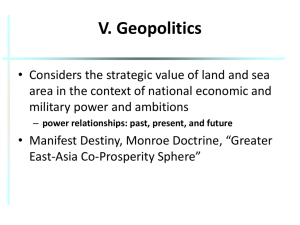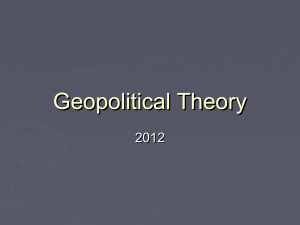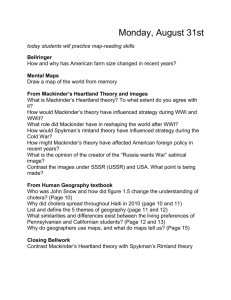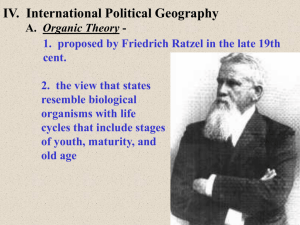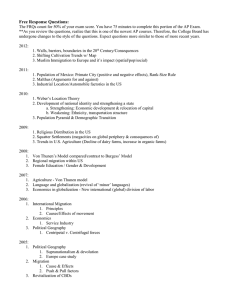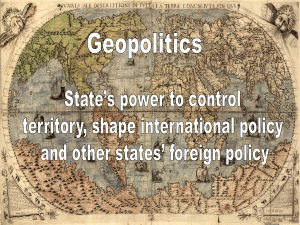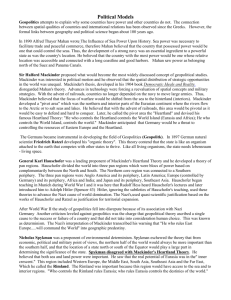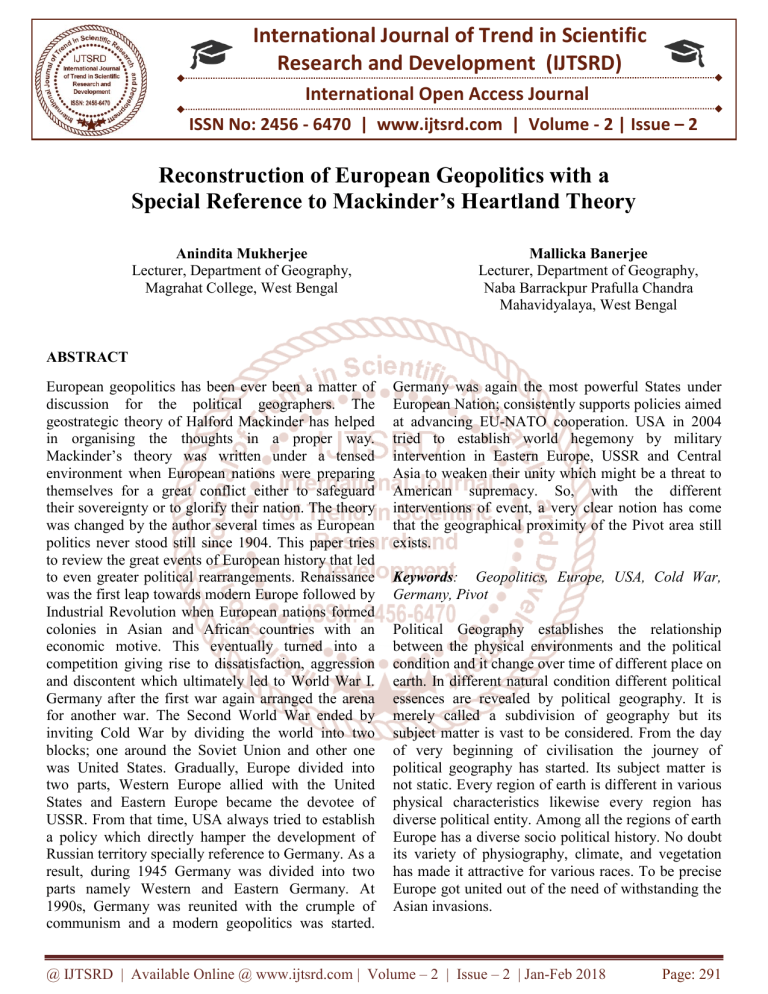
International Journal of Trend in Scientific
Research and Development (IJTSRD)
International Open Access Journal
ISSN No: 2456 - 6470 | www.ijtsrd.com | Volume - 2 | Issue – 2
Reconstruction of European Geopolitics with a
Special Reference to Mackinder’s Heartland Theory
Anindita Mukherjee
Lecturer, Department of Geography,
Magrahat College, West Bengal
Mallicka Banerjee
Lecturer, Department of Geography,
Naba Barrackpur Prafulla Chandra
Mahavidyalaya, West Bengal
ABSTRACT
European geopolitics has been ever been a matter of
discussion for the political geographers. The
geostrategic theory of Halford Mackinder has helped
in organising the thoughts in a proper way.
Mackinder’s theory was written under a tensed
environment when European nations were preparing
themselves for a great conflict either to safeguard
their sovereignty or to glorify their nation. The theory
was changed by the author several times as European
politics never stood still since 1904. This paper tries
to review the great events of European history that led
to even greater political rearrangements. Renaissance
was the first leap towards modern Europe followed by
Industrial Revolution when European nations formed
colonies in Asian and African countries with an
economic motive. This eventually turned into a
competition giving rise to dissatisfaction, aggression
and discontent which ultimately led to World War I.
Germany after the first war again arranged the arena
for another war. The Second World War ended by
inviting Cold War by dividing the world into two
blocks; one around the Soviet Union and other one
was United States. Gradually, Europe divided into
two parts, Western Europe allied with the United
States and Eastern Europe became the devotee of
USSR. From that time, USA always tried to establish
a policy which directly hamper the development of
Russian territory specially reference to Germany. As a
result, during 1945 Germany was divided into two
parts namely Western and Eastern Germany. At
1990s, Germany was reunited with the crumple of
communism and a modern geopolitics was started.
Germany was again the most powerful States under
European Nation; consistently supports policies aimed
at advancing EU-NATO cooperation. USA in 2004
tried to establish world hegemony by military
intervention in Eastern Europe, USSR and Central
Asia to weaken their unity which might be a threat to
American supremacy. So, with the different
interventions of event, a very clear notion has come
that the geographical proximity of the Pivot area still
exists.
Keywords: Geopolitics, Europe, USA, Cold War,
Germany, Pivot
Political Geography establishes the relationship
between the physical environments and the political
condition and it change over time of different place on
earth. In different natural condition different political
essences are revealed by political geography. It is
merely called a subdivision of geography but its
subject matter is vast to be considered. From the day
of very beginning of civilisation the journey of
political geography has started. Its subject matter is
not static. Every region of earth is different in various
physical characteristics likewise every region has
diverse political entity. Among all the regions of earth
Europe has a diverse socio political history. No doubt
its variety of physiography, climate, and vegetation
has made it attractive for various races. To be precise
Europe got united out of the need of withstanding the
Asian invasions.
@ IJTSRD | Available Online @ www.ijtsrd.com | Volume – 2 | Issue – 2 | Jan-Feb 2018
Page: 291
International Journal of Trend in Scientific Research and Development (IJTSRD) ISSN: 2456-6470
Some major historical events of Europe like
Renaissance, industrial revolution led to political
changes of its countries. The history of Europe
significantly starts with its first Revolution with the
collapse of Carolingian empire in the tenth century
(Moore, 1987). Early modern European history
requires one to be familiar with the whole range of the
basic themes, facts and developments of that region:
the economic, and political crisis of Europe in the
later Middle Ages to the first stirrings of the so-called
Industrial Revolution; the Hundred Years War; the
Great Schism and the conciliar movement; the
Renaissance, humanism and the Reformation; the
expansion of Europe into the so-called new world and
its commerce with Asia; the so called Scientific
Revolution; the wars with in France, Germany, and
England and so on. (Fasolt, 2011).
The renaissance started in Italy in 1300 and spread to
rest of the Europe around 1450. It marked the end of
Christian-German civilisation and the beginning of
modern European history and modern government as
well. It was mention worthy that Renaissance was
mostly affecting the lives of upper class while the
peasantry or working class were far preoccupied by
the matters of livelihood. There was competition
among the city states of Italy aiming at their lack of
unity. As the Spanish and French armies invaded Italy
caused the downfall of city states (Merriman, 2004),
whereas territorial unification took place in Britain,
Spain etc.
Industrial revolution paved the way for modern
politics to set in. The inevitable result of it was
colonialism. Some European countries could manage
to conquer economically most viable colonies while
others became disappointed and angry by not getting
benefitted. This discontent and economic disparity
gave birth to an emotion of nationalism which later on
proved to be a disease for the world which lead to
wounds of first and second world war.
Modern Europe got framed after the incidence of
industrial revolution of the nineteenth century. It was
interesting to note the aftermath of industrial
revolution throughout Europe. In eighteenth century it
began in England. England was a resourceful country;
soon development of heavy industry took place here.
But at the same time many other European nations
were still limited to agrarian economy. Two phases of
development of industrial revolution could be
identified one from 1760-1815 and secondly from
1815 onwards. Cotton was the first industry to be
revolutionised (Hobson, 1902). In the later stages of
industrial revolution use of petroleum could easily
reduce the distance with far away continents. Thus the
consequence of this revolution can be summarised as
framing the cornerstone of capitalism. Industrial
revolution resulted to excessive production and that
too the need to find new markets for the goods,
Europe was saturated already and the Europe headed
to the East. Germany was an agrarian nation the
revolution hit here late but she responded very fast to
it transforming her to an industrial nation within a
span of 30 years only. As an outcome of this
revolution Europe took part in the game of Colonising
countries of Asia Africa and America. It was
interesting to note that not all the countries could have
a good hand from this colonial race. The motive of
colonisation was mainly economic. In this
competition a few European countries could get most
resourceful colonies but some countries could not
gain that much economic benefit from this banter.
This inequality enhanced the year old rivalries among
European countries to many a times.
However economy not only led to colonialism, like
other living being a nation also needed to grow with
time, she also needed food and nourishment that could
be achieved by amalgamation of adjacent weaker
lands (Dikshit, 1999). Some writers readily welcomed
imperial expansion. Now a very important theory of
Geopolitik by Ratzel came in this perspective with an
idea of unstatic border of nations. Geopolitics may be
confined between two or more neighbouring countries
but scientific advancement made the faraway lands
accessible and result was friction and even wars
between countries even far away from each other, this
is reflected in the theories of geostrategy trying to
meet a balance of power of the countries. In Europe
most of the countries had a history of old conflicts but
economic conflict made it naked. Great politicians felt
expansion can only bring internal stability to a nation,
a big a powerful nation can only gain respect out of
fear from the world. Nations started to strengthen
their armies rather they got engaged in a competition
of army. All European nations were viewing the same
dream of conquering the whole world. Britain, France,
Germany, Portugal and Russia were forerunners of the
race of colonialism. The patronage of royal families
of various nation conducted voyages to farfetched
lands of America, Asia and Africa. The foremost
objective was to increase trade but the immense
@ IJTSRD | Available Online @ www.ijtsrd.com | Volume – 2 | Issue – 2 | Jan-Feb 2018
Page: 292
International Journal of Trend in Scientific Research and Development (IJTSRD) ISSN: 2456-6470
treasure of those newly discovered nations led to
establishment of colonial empires (Thompson, 1957).
French colonial Empire was in nations of North
America, Caribbean Islands and India. British colonial
empire consisted of nations of North America, Africa
and Asia. German colonial empire was established in
East Africa, Mamoa islands, New Guinea and
Cameroon. Russian colonial empire comprises nations
from Black Sea to Pacific coast and in parts of
America. In several regions of North and South
America Spanish colonial empire was based on
(Pounds, 1963).
In The Mean Time in Europe situation heated up as to
fulfil political motives the nations who once met in
the battlefields or were old rivals had to form groups,
this caused political unrest and the seed of First World
War was put in ground. A series of small but
significant wars led to the big event. In 1875 war
officially commenced between Germany and France.
Germany made allies with Austria and Italy forming
‘League of Three Nations’ while England took the
side of France later on joined by Russia. While these
nations were engaged in direct conflict the media and
scholars of concerned nations continuously ignited the
fire of nationalism from within. It was interesting to
note that the present allies Britain, France and Russia
considered themselves enemy of each other in past but
the rise of Germany with a grand navy necessitated
the unity of the above mentioned nations.
The first chancellor Bismark who engineered a series
of wars that unified the German states into a
powerful German Empire under Prussian leadership,
according to him Germany was a satiated country and
had no intention to make any further expansion of her
territories. He tried to maintain a balance between the
contending European powers. After the Berlin
Congress Russian wrath was against Germany, hence
he felt the need off making alliance with Austria.
Later Russia approached with a suggestion of reviving
the old Three Emperors League of Russia, Germany
and Austria-Hungary (Guha Roy, 2010). Many
political ups and downs governed the European
politics in the coming years. But the following most
important event to take place was First World War,
though it started in Europe but it certainly had a
global effect as the colonies became part of the war
indirectly. The war was actually the end product of a
long sequence of events which began in 1871 but it
officially started in 1914. As history reveals no
European country wanted this war but it was an
outcome of long nurtured hatred and untamed
nationalist feeling. Many historians opine this war
was merely fought to save one’s own territory to
secure country’s pride and sovereignty. The
annexation of Alsace-Lorraine gave new fuel to
French nationalism and promoted Germanophobia in
France. Germany and England always had an
intention of forming a great empire on the other hand
France, Italy and Serbia had lost their lands so it was
their nationalist feeling that led them to the war. Even
situation of smaller Balkan states grew worse when
peace treaties were dishonoured and their existence
crisis became threatened (Thompson, 1957).
The war officially commenced between Serbia and
Austria. When whole Europe was engaged in war a
vital question came to the minds of great thinkers and
scholars that who will become the ruler of the world??
(Mackinder, 1904). Many tried to solve the riddle by
forming theories but which advancement of world
politics the theories also changed.
In this context the theory of Halford Mackinder had
tried to foretell about the leader of the world politics.
Halford Mackinder was a social determinist. He
always tended to superimpose the effect of physical
environment on its political condition. It was
rightfully an attempt to correlate between the larger
geographical and the larger historical generalizations.
Countries of Europe were involved in friction from
the very beginning of history; this was the underlying
fact of Mackinder’s theory. He made several changes
to the theory so a reflection of the changing politicogeographical scenario was very vividly postulated. In
1904 at Royal Geographical Society Mackinder
published a writing named “The Geographical Pivot
of History”. As a Member of Parliament it was rather
a warning for the British to strengthen their armies for
the advancing German troops.
Mackinder pointed to the pivotal nature of the vast
Eurasian region, inaccessible to sea-going vessels, but
an easy target for the nomads in antiquity. Mackinder
was convinced that Eurasia possessed sustainable
conditions for the development of military and
industrial powers. He considered Eurasia as World
Island. The geographical pivot according to him was
the centre of political power the European nations will
fight for was later named heartland in 1919. Lands of
Russia, China, Mongolia, Baluchistan and Iraq cover
the heartland. Geographically the area was unique
with Arctic sea in north Himalaya in south, Siberia in
@ IJTSRD | Available Online @ www.ijtsrd.com | Volume – 2 | Issue – 2 | Jan-Feb 2018
Page: 293
International Journal of Trend in Scientific Research and Development (IJTSRD) ISSN: 2456-6470
Figure 1: Mackinder’s ‘pivot area’, the ‘inner’ and ‘outer crescents’: Source: H.J. Mackinder, ‘The
Geographical Pivot of History’, The Geographical Journal, vol. 24, no. 4, 1904, p. 435.
east and Volga River in west. This is an area of inland
drainage which is merely impregnable expecting a
narrow corridor through Caspian Sea. This region is
also full of natural resources like fertile agricultural
land for development of agriculture and plain land to
set up transportation routes and industries. From past
the great leaders wanted to keep a control of this land.
As per Mackinder after the world war one who will
capture the heartland will be ruler of the earth.
Mackinder was anxious about the rise of pivot area
and wanted his country to check by maintaining the
marginal areas. He feared that Germany may one day
capture the heartland then the coastal crescent will be
exposed and easily conquerable endangering the
sovereignty of England. On the other had there was a
fear of the dominance of China over Russia then
China and Japan may form a yellow peril. In 1919
with the end of the world war Mackinder again made
changes to his theory as Germany made an attack to
Russia through steppe corridor so he thought the
countries between Germany and the heartland should
make a buffer for the protection of heartland.
(Ochssée, 2007)
The First World War ended with Treaty of Versailles
where Germany was accused for the war and had a
burden of great compensation to pay. All these were
to destroy the backbone of the nation. The war had
various consequences in politico geographical point of
view but the remarkable ones were monarchian crisis
as the four great empires of Hungary-Austria, Turkey,
Russia and Germany fell. The big power of east
Europe was disintegrated into small independent
nations of Czechoslovakia, Poland, and Yugoslavia
etc.
After this devastating war peace was the call of the
time. Thus League of Nations was established but it
failed to restore peace and the abnormal nationalist
feeling led to another world war. World War II is
considered to be the continuation the previous world
war. It was basically to take revenge of the previous
war. In Germany economy collapsed, people were
starving and in the midst of all these there was not any
air for the democracy to live. The power went into the
hands of Hilter and his Nazi party with his plan in
mind to form a ‘Great German Nation’ by unifying all
Germans throughout the Europe followed by a
cleanup of ‘non German’ Jews from the country. The
rise of fascism by Mussolini and military expansion of
Japan formed the platform for the war. Germany was
supported by Italy and Japan. Although the war weary
British and French followed the policy of
appeasement to Hilter but he deliberately opposed the
treaty of Versailles by military expansion and Britain
finally marched against Germany officially breaking
out the world war. The geographical territory of the
second war was even wider, Asian countries were
now directly involved in the war.
The various images of politics of that time and its
change were portrayed by Mackinder in his book of
@ IJTSRD | Available Online @ www.ijtsrd.com | Volume – 2 | Issue – 2 | Jan-Feb 2018
Page: 294
International Journal of Trend in Scientific Research and Development (IJTSRD) ISSN: 2456-6470
‘The Round World and Winning of Peace’. After The
Defeat of Germany in World War II Mackinder no
more considered it compatible to capture heartland
rather he saw a possibility of a nation within heartland
to rule it as the war marked the rise of two
superpowers- Russia and America. The Eastern
Europe eventually went into the hands of Russia while
the west was reorganised by America (Foster, 1974).
The end of the Second World War did not provide any
platform which brings the global powers to a peaceful
space. On the converse, it resulted in a new invisible
conflict. Gradually the whole world divided into two
power blocks; one around the Soviet Union and other
one was United States.
Simultaneously, other
countries were being forced to choose any one power
blocks. The United States was the immense defeater
of World War as it’s looses less human and material
during the war and it became world’s leading military
power. It was the only country with the capacity to
produce nuclear weapons (In 1945, USA dropped the
atomic bomb namely Little Boy in Japan). It also
confirmed its status as the world’s leading economic
power, in terms of the production of Industrial and
Agricultural products. (Roberts, 2005)
The Cold War was a prolonged struggle between the
United States and the Soviet Union that began with
the surrender of Hitler’s Germany. The Cold War was
not completely about the struggle between the US and
the USSR but it affected much too the European
continent. As a result, whole Europe divided into two
parts, Western Europe allied with the United States
and Eastern Europe became the devotee of USSR.
The policy taken by United States was very hostile
against the development of Russian territory which
directly put its impact on Germany. During 1945,
western allies gradually occupying the different parts
of Germany; USA occupied the Southern part, British
occupied the West and North portion, France the
South-West, and the Soviet controlled the Central
Germany. The Eastern part was administered by
Poland, except the town of Kaliningrad, which were
annexed by the USSR. As a result, whole Germany
divided into two parts Eastern and Western on the
basis of dominated power. (History, 1991)
As per the heartland theory it met apprehension as
well as criticism with the US-USSR rivalry claiming
to be ‘the pivot of Asia on one side and on the other
side as application of Mackinder’s idea to
contemporary Asia will be misplaced.
During 1947-48, Western allied became more
threatful towards the technological development of
Eastern Europe around Germany. Therefore, United
States demanded for a more powerful support from
France and UK. From 1949, Western Europe felt the
economic fall and sought for help from US alliance.
In the mean time, US also joined with the NATO to
secure the ocean from territorial out fall. The North
Atlantic Treaty Organization thus devoted to United
States military support for collective security in
Europe. It permanently linked the United States and
Europe on behalf of internal security. Here again the
European continent played a very crucial role in
determining the world power politics.
Nevertheless the two Great Powers never came
directly in the battle ground; they pressed the world
on behalf of economic and geo-political power on
several events. In, 1961 the formation of Berlin Wall
was the major event which showed how the people of
Germany is divided on the ideology based economic
structure. Political expert Raymond Aron, faultlessly
defined the Cold War as, it hits the nail on the Head:
‘Impossible peace, improbable war’. By the end of
1989 to 1990, Cold War was announced to its end
with the fall of the Berlin Wall and the crumple of the
Communist regimes in Eastern Europe.(CVCE, 2016)
The significance of Germany although it’s crushing
defeat in the World War II was never less. By the end
of the Cold War, German unification showed a
monumental shift in the geopolitical realities that had
defined foreign policy of Germany. Germany was
become the largest country of Europe once again, and
the Soviet threat, which had served to unite West
Germany with its pro western neighbours. Until 1994,
Germany was constitutionally barred from deploying
its armed forces abroad. Till 2008, approximately
7,400 German troops are deployed in peacekeeping,
stabilization and restoration missions worldwide.
However, the foreign policy of Germany was
continuous to evolve. Since the end of the Cold War,
the relationship of Germany with the United States
have been shaped by various factors; which includes
Germany’s growing support for a stronger European
Union, and its continued allegiance to NATO as the
primary guarantor of European security.
Since unification, Germany has played a potential role
behind the EU’s enlargement eastward, integration of
European countries, European foreign policy
coordination, and the development of a European
Security and Defense Policy (ESDP). Former
@ IJTSRD | Available Online @ www.ijtsrd.com | Volume – 2 | Issue – 2 | Jan-Feb 2018
Page: 295
International Journal of Trend in Scientific Research and Development (IJTSRD) ISSN: 2456-6470
European Chancellor Merkel argues that a more
consistent European foreign, security, and defence
policy device will in fact enable Europe to be more
effective transatlantic partners to the United States.
Germany consistently supports policies aimed at
advancing EU-NATO cooperation. Berlin’s dual
commitment to the EU and NATO suggests that to
find a middle path of cooperation between the two
institutions. (Belkin, 2009)
After the seven decades of World War II, present geopolitical relations are not as profound as the world
imagine. A majority of Germans believe it is more
important for Germany to have strong ties with the
United States than with Russia. For the Americans,
most important event in U.S.-German relations over
the past 75 years remains World War II and the
Holocaust, to the extent of one event that is the 1989
fall of the Berlin Wall. In the eyes of most Americans,
the “special relationship” with Britain is still stronger
than that with Germany. Americans want Germany to
play a more active military role in the world, but
Germans insistently disagree. Economically and
geopolitically, the U.S.-German alliance has become
the key player of the trans-Atlantic relationship in the
21stcentury. Despite their disagreements at the time
over the Iraq War and U.S. National Security Agency
spying, Americans and Germans view each other as
reliable allies. (Germany and the United States:
Reliable Allies, 2015).
On the ground of present geopolitical circumstances,
Germany is one of the United States’ contiguous allies
in Europe. From the political point of view, Germany
stands at the center of European associations and
plays a key role as a member of the G-7, G-20, North
Atlantic Treaty Organization (NATO) and the
Organization on Security and Cooperation in Europe
(OSCE). Most recently, the United States and
Germany have been working closely together to
counter Russian aggression in Ukraine, confer a
political solution to the crisis in Syria, and to curtail
the Iranian nuclear program.
In 2016, Germany hold the Chairmanship of the
OSCE where they helped continue the OSCE’s
important work preventing conflict, promoting
democracy, human rights and the rule of law, and
encouraging open and transparent economies. The
United States recognizes that the security and
prosperity of the United States and Germany
significantly depend on each other. (U.S. Relations
With Germany, 2016)
The formation of Economic Union was very
significant in uniting Europe and ending year long
hostility through trade. Opening of domestic market
and agreements on free trade gave a common mean
for economic benefit for various nations. The Euro
currency was an extraordinary step in making trade
easier and represents a symbol of the close ties
between the nations. (Bradley, 2012)
The debate grew afterwards whether or not the
heartland theory is applicable to the modern
circumstances. It was to be admitted that the
geostrategic position of countries of heartland always
tempted other countries to explore them. End of the
Cold War didn’t bring lasting peace as nations were
still in competition which reprises many ideas of
Mackinder. According to Dhaka, the antipodal
arrangement of continents and oceans suggest a
tetrahedral shape and the heartland buy virtue of its
place in the tetrahedron is in the crucial position. US
aimed at checking the influence of Russia in the pivot
region using EU and NATO. With U.S war against
Iraq in 2013 broke down the alliance of Britain and
Germany. Britain belonged to the Outer Crescent and
Germany was positioned at the intersection of
Midland ocean world and Heartland. During cold war
its former location proved to be better but after the fall
of USSR its heartland location was reasserted as a
decisive factor in policy making. After Cold War
Britain was struck to its US alliance but Germany
weakened it and re-invigorated EU. As UK tried to do
in 1904, USA in 2004 tried to establish world
hegemony by military intervention in Eastern Europe,
USSR and Central Asia to weaken their unity which
might be a threat to American supremacy. So it will
not be totally wrong to consider the Heartland as
power pivot in recent times also (Megoran, 2005).
One of the key problems of modern European Union
is the ‘interventionists’ like the French and ‘freetraders’- Germany. France wants to give safeguard to
their national industries and ensure their safe
economic future. This kind of protectionism is the
most distinct anti-European strategy. On the other
hand, the free traders, like Germany, want to impose
less regulation to make European trade as a whole
cheaper and more competent. However, unlike the
Cold War these nations have many more areas of
solidarity which remove the possibility of these small
conflicts. (Bradley, 2012)
@ IJTSRD | Available Online @ www.ijtsrd.com | Volume – 2 | Issue – 2 | Jan-Feb 2018
Page: 296
International Journal of Trend in Scientific Research and Development (IJTSRD) ISSN: 2456-6470
This paper concludes that, till now Central Asia is
playing a pivotal role in determining the world power
politics. From the 2nd world war, each power strives to
control to the region’s resources. For the European
Union, the main goal is to achieve economic access
while concurrently promoting the democratization of
those countries that are politically unstable. Central
Asia is considered as very influential to each power.
However, in the light of Mackinder’s notion of “the
actual balance at any given time” shows the
geographical proximity of the Pivot area. On the other
hand, USA and EU are building up alliances with
regional countries in order to maximize their
economic and political influence (Scott & Alcenat,
2008). Mackinder's theory also made has influenced
Western powers' strategic thinking during the Cold
War between the Soviet Union and the United States.
11. Friedrich, S. E. (2013). Germany and Russia in
2030. Berlin: German Federal Foreign Office.
12. Germany and the United States: Reliable Allies.
(2015, May 7). Retrieved October 17, 2017, from
Pew Research Center: http://www.pewglobal.org
13. Guha Roy, S. (2010).
Pragatishil Proshak.
Europe 1789-1945.
14. Hara, O., Heffernan, M., & Endfield, G. (2005).
Halford Mackinder, The Geographical Pivot, and
British Perception of Central Asia. In B. Blouet,
Global Strategy: Mackinder and the Defence of
the West. London: Frank Class.
15. Hobson, J. (1902). Imperialism: A Study . U.K:
Cosimo Classics.
REFERENCES:
16. Mackinder, H. (1919). Democratic Ideals and
Reality: A Study in the Politics of Reconstruction.
London: Constable and Company.
1. Adhikary, S. (1997). Political Geography. Delhi:
Rawat Publication.
17. Mackinder, H. (1904). The Geographical Pivot of
History. The Geographical Journal .
2. Belkin, P. (2009). German Foreign and Security
Policy: Trends and Transatlantic Implications .
Congressional Research Service.
18. Mackinder, H. (1943). The Round World and the
Winning of the Peace. Foreign Affairs .
3. Chowdhury, S., & Kafi, A. (2015). The Heartland
Theory of Sir Halford John Mackinder:
Justification of Foreign Policy of United Stated
and Russia in Central Asia. Journal of Liberty and
International Affairs , 1-13.
4. Dahlman, C., & Gallaher, C. (2009). Key
Concepts in Political Geography. Delhi: Sage
Publications India Ltd.
5. David, T. (1957). Europe Since Nepoleon.
Penguin Books.
6. Dikshit, R. (1999). Political Geography, The
Spatiality of Politics. Tata Mc Grow Hill
Publication.
7. Dodds, K. (2005). Geopolitics : A Very Short
Introduction . UK: Oxford University Press.
8. Dwivedi, R. (2007). Political Geography, The
Spatiality of Politics. Allahabad: Chaitanya
Publishing Home.
9. Esmailov, E., & Papaya, V. (2010). Rethinking
Central Eurasia, Central Asia Caucasus. Institute
Silk Road Studies Programme.
10. Foster, M. (1974). The Wrld at War. London:
BCA.
19. Marriman, J. (2004). A History of Modern
Europe: From the Renaissance to the Present.
New York: W.W Norton.
20. Megoran, N., & Sarapova, S. (2005). Mackinder's
Heartland a Help or Hindrance in Understanding
Central Asia's International Relations. Central
Asia and the Caucasus .
21. Megoran, N., Sarapova, S., & Faizullaev, A.
(2005). Halford Mackinder’s ‘Heartland’ – a
Helpor Hindrance? The Geographical Journal .
22. Merriman, J. (2004). A History of Modern
Europe: From the Renaissance to the Present.
New York: W.W. Norton.
23. Moore, R. I. (2000). The First European
Revolution, c. 970-1215. U.K: Oxford: Blackwell
Publishers.
24. Morgan, S. (2005). Mackinder's "Heartland": A
Help or Hinderance in understanding Central
Asia's International Relations. Central Asia and
Caucasus( Special Issue).
25. Ochssaa, B. T. (2007, July). Exploring
Geopolitics. Retrieved November 2, 2017, from
Exploring: http://www.exploringgeopolitics.org
@ IJTSRD | Available Online @ www.ijtsrd.com | Volume – 2 | Issue – 2 | Jan-Feb 2018
Page: 297
International Journal of Trend in Scientific Research and Development (IJTSRD) ISSN: 2456-6470
26. Palmer, R., Kolton, J., & Kramer, L. (2013). A
History of Europe of the Modern World. New
York: Mc Grow Hill Publication.
27. Pounds, N. (1990). An Historical Geography of
Europe. New York: Cambridge University Press.
28. Pounds, N. (1963). Political Geography. Delhi:
Tata Mc Grow Hill Publishing House.
29. Scott, M., & Alcenat, W. (2008). Revisiting the
Pivot: The Influence of Heartland Theory in Great
Power Politics. Macalester: Macalester College.
30. Siddhartha, K. (2000). Nation State , Territory
and Geopolitics. Kishalaya.
31. Sloan, J. (1999). Sir Halford J. Mackinder: The
Heartland Theory Then and Now. Journal of
Strategic Studies .
32. Suri, J. (n.d.). Conflict and Co-operation in the
Cold War: New Directions in Contemporary
Historical Research. Journal of Contemporary
History , 5-9.
33. U.S. Relations With Germany. (2016, December
21). Retrieved October 16, 2017, from U.S
Department of State: https://www.state.gov
34. Ugarriza, J. (2009). Ideologies and conflict in the
post-Cold War. International Journal of Conflict
Management , 82-104.
@ IJTSRD | Available Online @ www.ijtsrd.com | Volume – 2 | Issue – 2 | Jan-Feb 2018
Page: 298

